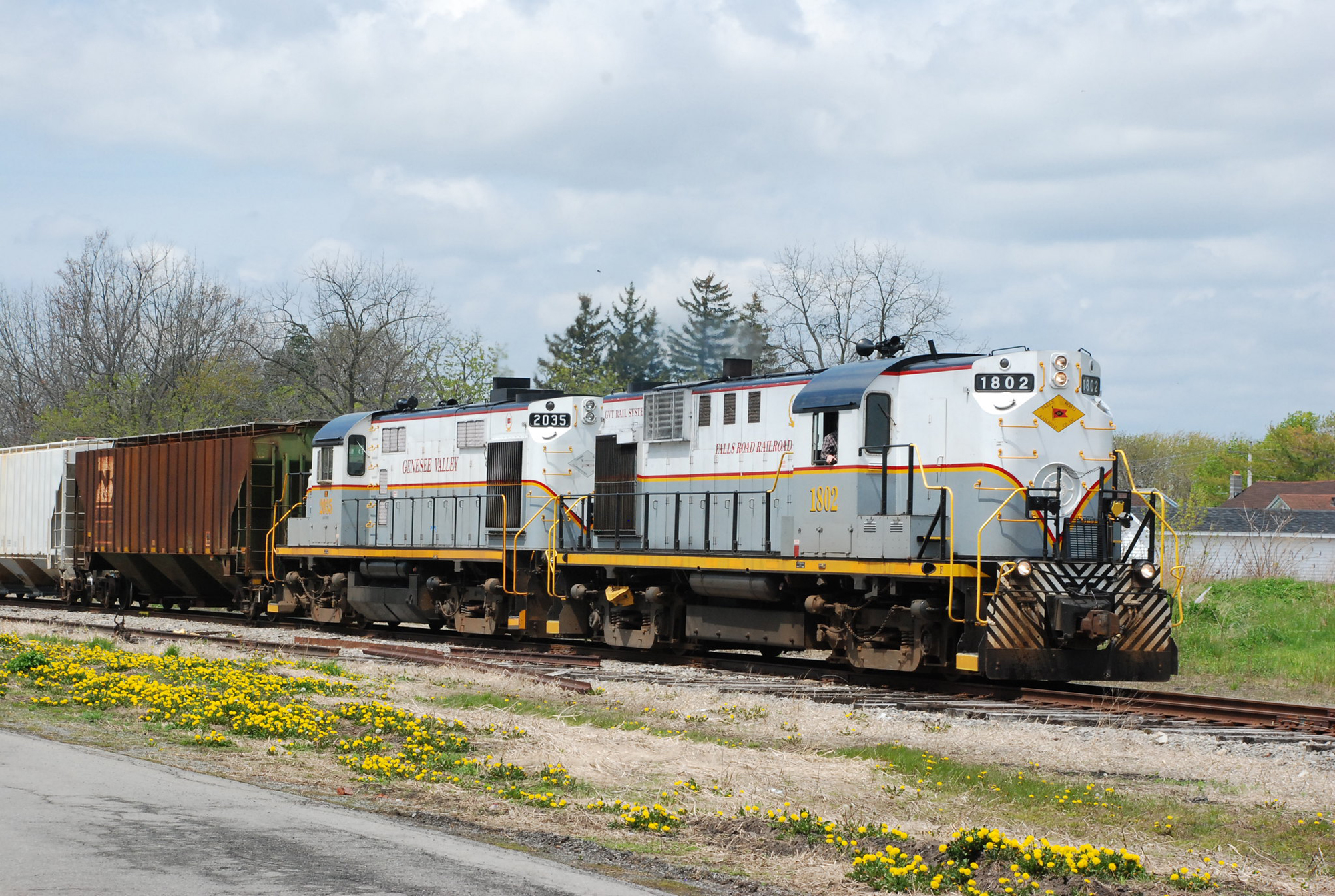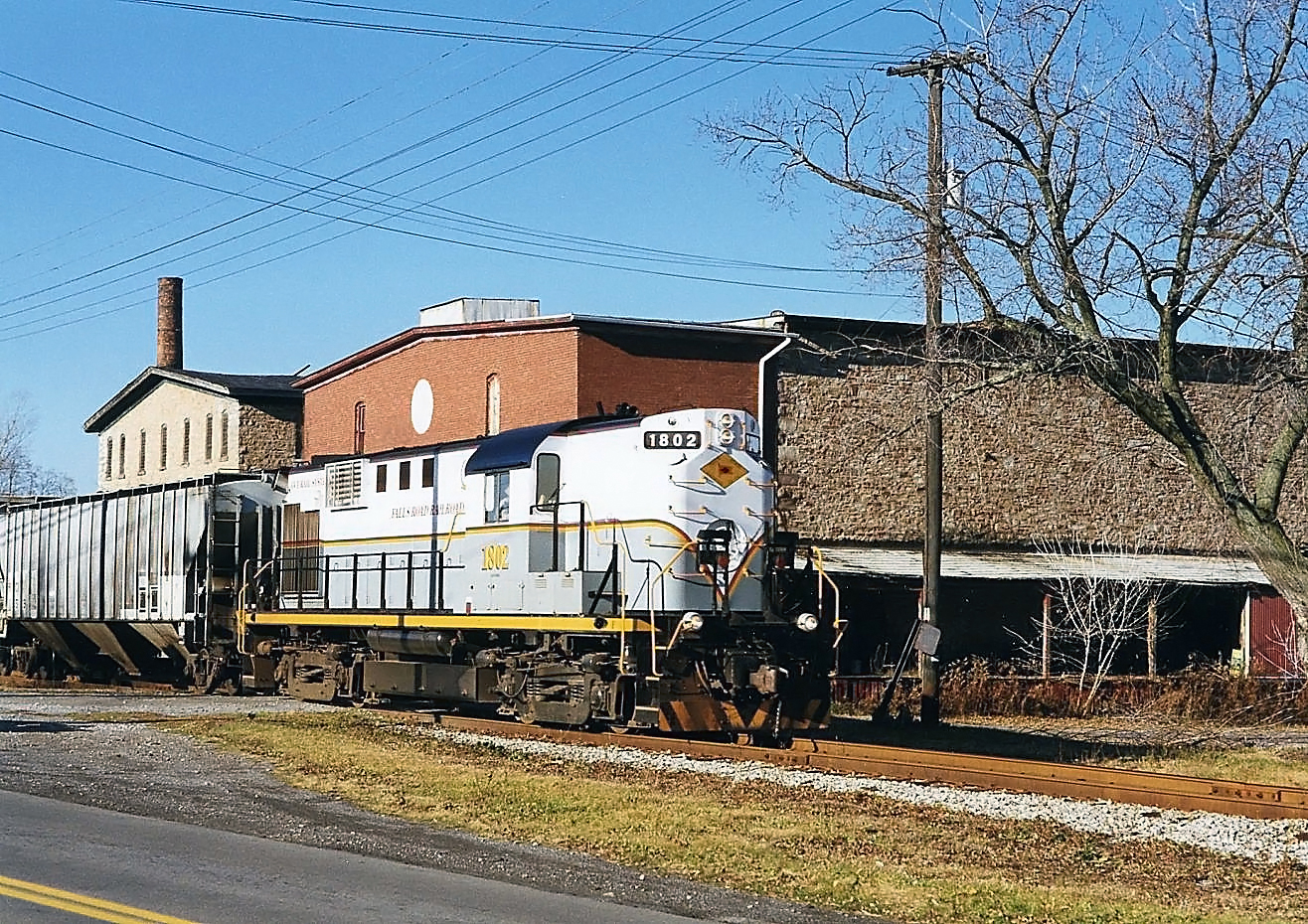Falls Road Railroad: GVT's Western NY Short Line
Published: August 14, 2024
By: Adam Burns
The Falls Road Railroad (FRR) is a notable short line in Western New York, known for its blend of historical legacy, operational efficiency, and critical economic contributions to the region.
Under the management of Genesee Valley Transportation Company (GVT), the FRR continues to thrive, serving a diverse array of industries and preserving the rich rail heritage of the area.
The railroad maintains nearly 42 miles of New York Central's former branch between Niagara Falls and Rochester. This article delves into the history, operations, challenges, and future prospects of the Falls Road Railroad.
 Falls Road Railroad RS11 #1802 has dropped off the tank cars from train LB-1 and it is headed eastbound at Albion, New York on May 15, 2020. Also assisting is GVT RS32 #2035. Doug Kroll photo.
Falls Road Railroad RS11 #1802 has dropped off the tank cars from train LB-1 and it is headed eastbound at Albion, New York on May 15, 2020. Also assisting is GVT RS32 #2035. Doug Kroll photo.Historic Background
The origins of the Falls Road Railroad date back to the expansion of the railroad network in the 19th century. The line was initially constructed by the New York Central Railroad as part of its main line to Niagara Falls.
Spanning approximately 45 miles, the route runs from Lockport, New York, to Brockport, New York, through the scenic Erie Canal region.
The railroad was crucial in the transport of agricultural products, raw materials, and manufactured goods from local industries to larger markets, contributing significantly to the economic development of Western New York.
Acquisition by Genesee Valley Transportation
The decline of the major railroads in the late 20th century left many smaller lines facing abandonment or neglect. To preserve and revitalize these vital transportation links, Genesee Valley Transportation Company stepped in. In 1996, GVT launched the Falls Road Railroad following an agreement with Conrail, marking a significant milestone in its strategic expansion.
GVT’s acquisition aimed to restore reliable service, improve infrastructure, and attract new business to the line. The commitment to service excellence and customer satisfaction has been a cornerstone of GVT’s operational philosophy, which continued with the FRR.
Operations
The FRR boasts a diverse freight portfolio, handling agricultural products, perishables, petrochemicals, and plastics. Run-through unit trains operated by CSX Transportation have become a common sight, with inbound corn transported to a biofuel plant operated by Western New York Energy, LLC, near Medina, and carbon dioxide shipped from the Air Products facility along the line.
As a key enterprise for GVT, FRR features a T3 transloading facility located in Lockport Yard, offering vital switching services to reach off-line customers. Additionally, the Scranton Operations Center in Scranton, Pennsylvania, serves as the headquarters for dispatching operations, ensuring smooth and efficient management of the Falls Road Railroad’s activities.
The FRR's maintains a single connection with CSX at Lockport Yard. In addition, it hosts passenger excursions in conjunction with the Medina Railroad Museum, using Genesee Valley’s locomotives and museum’s rolling stock.
Key Segments and Industry Focus
- **Agricultural Products:** Given its location in a region rich in agriculture, the FRR is essential for transporting grains, feed, and other agricultural commodities to processing plants and markets.
- **Industrial Goods:** The railroad serves various industrial customers, including manufacturers of building materials, plastics, and chemicals.
- **Transloading Facilities:** Understanding the importance of flexibility in modern logistics, FRR operates several transloading facilities, enabling the efficient transfer of goods between rail and truck. This service extends the railroad’s reach to customers without direct rail access, enhancing overall supply chain efficiency.
 Falls Road Railroad RS11 #1802 passes some old cannery buildings in Gasport, New York on December 2, 1998. Doug Kroll photo.
Falls Road Railroad RS11 #1802 passes some old cannery buildings in Gasport, New York on December 2, 1998. Doug Kroll photo.Locomotive Fleet and Maintenance
While power from all of GVT's properties can be found in service on the short line from time to time, the railroad utilizes just one RS11 lettered as the Falls Road Railroad, #1802.
Economic and Environmental Impact
The economic impact of the Falls Road Railroad on Western New York is substantial. By providing cost-effective and reliable transportation, FRR supports local businesses, enhances supply chain efficiency, and opens access to broader markets. This, in turn, stimulates regional economic activity and fosters job creation.
Moreover, rail transport is inherently more environmentally friendly compared to road transport. By moving large volumes of goods efficiently, FRR contributes to reduced carbon emissions and decreased highway congestion, underscoring its role in promoting sustainable transportation solutions.
Preservation and Heritage
Railroad heritage preservation is an essential aspect of FRR’s identity. The railroad operates several historic locomotives and rolling stock, preserving a living history of American railroading. These efforts attract rail enthusiasts and tourists, further contributing to the local economy and fostering a deeper appreciation for the region’s rail history.
Diesel Roster
| Road Number | Model Type | Builder | Serial Number | Completion Date | Notes |
|---|---|---|---|---|---|
| 1802 | RS11 | Alco | 83027 | 2/1959 | ex-Winchester & Western #863; ex-Norfolk & Western #2863; built as Nickel Plate #863. |
Conclusion
The Falls Road Railroad stands as a testament to the enduring value of shortline railroads in the American transportation landscape.
From its historical roots as part of the New York Central network to its current operations under Genesee Valley Transportation, the FRR has consistently demonstrated its importance to the economic vitality and cultural heritage of Western New York.
Through its commitment to reliable service, technological innovation, safety, and community engagement, the Falls Road Railroad continues to play a pivotal role in connecting communities, supporting local businesses, and preserving the rich railroading legacy of the region. As it looks to the future, FRR remains well-positioned to adapt to new challenges and seize opportunities, ensuring it remains a vital asset for generations to come.
Recent Articles
-
Rio Grande 2-8-2 Locomotives (K-37): Specs, Roster, Photos
Apr 15, 25 12:57 PM
Rio Grande's Class K-37 Mikes were itsdge steamers to enter service in the late 1920s. Today, all but two survive. -
Rio Grande 2-8-2 Locomotives (K-36): Specs, Roster, Photos
Apr 15, 25 11:09 AM
The Rio Grande's K-36 2-8-2s were its last new Mikados purchased for narrow-gauge use. Today, all but one survives. -
Rio Grande 2-8-2 Locomotives (Class K-28): Specs, Roster, Photos
Apr 14, 25 10:24 PM
Rio Grande's Class K-28 Mikados were its newest narrow-gauge steam locomotives since the Mudhens of the early 1900s. Today, three survive.


